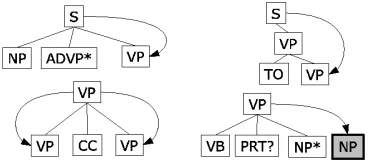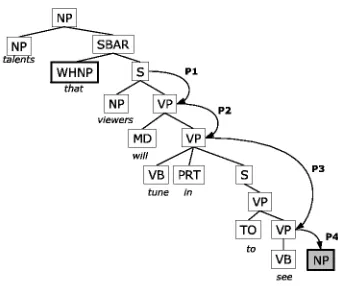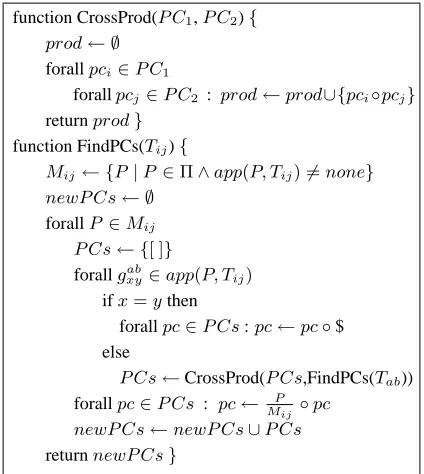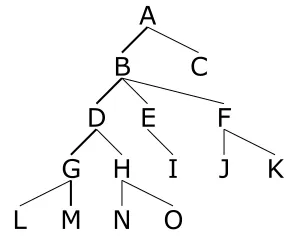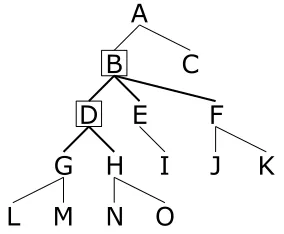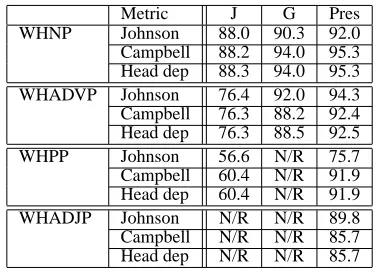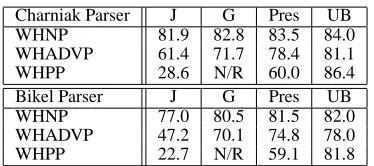Recovery of Empty Nodes in Parse Structures
Denis Filimonov1 1University of Maryland
College Park, MD 20742 den@cs.umd.edu
Mary P. Harper1,2 2Purdue University
West Lafayette, IN 47907 mharper@casl.umd.edu
Abstract
In this paper, we describe a new algorithm for recovering WH-trace empty nodes. Our approach combines a set of hand-written patterns together with a probabilistic model. Because the patterns heavily utilize regu-lar expressions, the pertinent tree structures are covered using a limited number of pat-terns. The probabilistic model is essen-tially a probabilistic context-free grammar (PCFG) approach with the patterns acting as the terminals in production rules. We eval-uate the algorithm’s performance on gold trees and parser output using three differ-ent metrics. Our method compares favorably with state-of-the-art algorithms that recover WH-traces.
1 Introduction
In this paper, we describe a new algorithm for re-covering WH-trace empty nodes in gold parse trees in the Penn Treebank and, more importantly, in automatically generated parses. This problem has only been investigated by a handful of researchers and yet it is important for a variety of applications, e.g., mapping parse trees to logical representations and structured representations for language mod-eling. For example, SuperARV language models (LMs) (Wang and Harper, 2002; Wang et al., 2003), which tightly integrate lexical features and syntactic constraints, have been found to significantly reduce word error in English speech recognition tasks. In order to generate SuperARV LM training, a state-of-the-art parser is used to parse training material and then a rule-based transformer converts the parses to
the SuperARV representation. The transformer is quite accurate when operating on treebank parses; however, trees produced by the parser lack one im-portant type of information – gaps, particularly WH-traces, which are important for more accurate ex-traction of the SuperARVs.
Approaches applied to the problem of empty node recovery fall into three categories. Dienes and Dubey (2003) recover empty nodes as a pre-processing step and pass strings with gaps to their parser. Their performance was comparable to (Johnson, 2002); however, they did not evaluate the impact of the gaps on parser performance. Collins (1999) directly incorporated wh-traces into his Model 3 parser, but he did not evaluate gap in-sertion accuracy directly. Most of the research be-longs to the third category, i.e., post-processing of parser output. Johnson (2002) used corpus-induced patterns to insert gaps into both gold standard trees and parser output. Campbell (2004) developed a set of linguistically motivated hand-written rules for gap insertion. Machine learning methods were em-ployed by (Higgins, 2003; Levy and Manning, 2004; Gabbard et al., 2006).
In this paper, we develop a probabilistic model that uses a set of patterns and tree matching to guide the insertion of WH-traces. We only insert traces of non-null WH-phrases, as they are most relevant for our goals. Our effort differs from the previous ap-proaches in that we have developed an algorithm for the insertion of gaps that combines a small set of ex-pressive patterns with a probabilistic grammar-based model.
2 The Model
[image:2.612.90.274.283.365.2]We have developed a set of tree-matching patterns that are applied to propagate a gap down a path in a parse tree. Pattern examples appear in Figure 1. Each pattern is designed to match a subtree (a root and one or more levels below that root) and used to guide the propagation of the trace into one or more nodes at the terminal level of the pattern (indicated using directed edges). Since tree-matching patterns are applied in a top-down fashion, multiple patterns can match the same subtree and allow alternative ways to propagate a gap. Hence, we have developed a probabilistic model to select among the alterna-tive paths. We have created 24 patterns for WHNP traces, 16 for WHADVP, 18 for WHPP, and 11 for WHADJP.
Figure 1: Examples of tree-matching patterns
Before describing our model, we first introduce some notation.
• TN
ij is a tree dominating the string of words
be-tween positionsiandjwithN being the label of the root. We assume there are no unary chains like N−X−...−Y−N(which could be collapsed to a single nodeN) in the tree, so thatTijN uniquely describes the subtree.
• A gap location gcdab,N is represented as a tuple (gaptype, ancstr(a, b, N), c, d), where gaptype is the type of the gap, (e.g., whnpfor a WHNP trace),ancstr(a, b, N)is the gap’s nearest ances-tor, witha andbbeing its span and N being its label, and c andd indicating where the gap can be inserted. Note that a gap’s location is specified precisely whenc = d. If the gap is yet to be in-serted into its final location but will be inin-serted somewhere inside ancstr(a, b, N), then we set c=aandd=b.
• ancstr(a, b, N)in the tuple forgxyab,N is the tree TN
ab. • p(gab,N
xy |gaptype, TijN) is the probability that a
gap ofgaptypeis located betweenxandy, witha
andbbeing the span of its ancestor, andi≤a≤
x≤y≤b≤j.
Given this notation, our model is tasked to identify the best location for the gap in a parse tree among the alternatives, i.e.,
argmax
x,a,b,N P r(g ab,N
xx |T, gaptype)
wheregxxab,N represents a gap location in a tree, and
T = TN
ij is the subtree of the parse tree whose
root node is the nearest ancestor node dominating the WH-phrase, excluding the WH-node itself, and gaptypeis the type of the gap. In order to simplify the notation, we will omit the root labelsN inTijN andgab,N
xy , implying that they match where
appropri-ate.
To guide this model, we utilize tree-matching pat-terns (see Figure 1), which are formally defined as functions:
ptrn:T × G →Γ∪ {none}
whereT is the space of parse trees, G is the space of gap types, and Γ is the space of gaps gcdab, andnone is a special value representing failure to match1. The application of a pattern is defined as: app(ptrn, τ, gaptype) = ptrn(τ, gaptype), where τ ∈ T andgaptype ∈ G. We define application of patterns as follows:
app(ptrn, Tij, gaptype) → gxyab:i≤a≤x < y≤b≤j app(ptrn, Tij, gaptype) → gxxab:i≤a≤x≤b≤j app(ptrn, Tij, gaptype) → none
Because patterns are uniquely associated with spe-cific gap types, we will omitgaptypeto simplify the notation. Application is a function defined for every pair(ptrn, Tij)with fixedgaptype. Patterns are
ap-plied to the root ofTij, not to an arbitrary subtree.
Consider an example of pattern application shown in Figure 2. The tree contains a relative clause such that the WHNP-phrase that was moved from some location inside the subtree of its sister node S.
2viewers3will4tune5in6to7see8
1
Figure 2: A pattern application example
[image:3.612.98.259.331.484.2]Now suppose there is a pattern P1 that matches the tree T28 indicating that the gap is some-where in its subtree T38 (will tune in to see), i.e., app(P1, T28) → g3838. The process of applying pat-terns continues until the patternP4 proposes an ex-act location for the gap:app(P4, T78) =g7888.
Figure 3: Another pattern application example
Suppose that, in addition to the pattern applica-tions shown in Figure 2, there is one more, namely: app(P5, T48) → g48
66. The sequence of patterns P1, P2, P5 proposes an alternative grammatically plausible location for the gap, as shown in Figure 3. Notice that the combination of the two sequences produces a tree of patterns, as shown in Figure 4, and this pattern tree covers much of the structure of theT28subtree.
2.1 Tree Classes
The number of unique subtrees that contain WH-phrases is essentially infinite; hence, modeling them directly is infeasible. However, trees with varying details, e.g., optional adverbials, often can be
char-P1
P2
P3 C
D P4,$
E A
B
F P5,$
Figure 4: Pattern tree
acterized by the same tree of patterns. Hence, we can represent the space of trees by utilizing a rela-tively small set of classes of trees that are determined by their tree of pattern applications.
LetΠbe the set of all patterns. We define the set of patterns matching treeTij as follows:
M(Tij) ={P |P ∈Π∧app(P, Tij)6=none}
To enable recursive application:
app(ptrn, gxyab) =
½
app(ptrn, Tab) ifx < y
none ifx=y
A Pattern Chain P C is a sequence of pairs of patterns and sets of pattern sets, terminated by $, i.e., (p1
M1,
p2
M2, ...
pn
Mn,$), where ∀i pi ∈ Mi ⊂
Π. Mi = M(Tab), where Tab is the result of
consequent application of the first i−1 patterns: app(pi−1, app(pi−2, ..., app(p1, Tαβ))) = gxyab, and
whereTαβis the subtree we started with, (T28in the example above). We define the application of a pat-tern chain P C = (p1
M1,
p2
M2, ...
pn
Mn,$) to a tree Tij
as:
app(P C, Tij) =app(pn, ...app(p2, app(p1, Tij)))
It is important to also define a function to map a tree to the set of pattern chains applicable to a particular tree. The pseudocode for this function called FindPCs appears in Figure 52. When ap-plied toTij, this function returns the set of all
pat-tern chains, applications of which would result in concrete gap locations. The algorithm is guaranteed to terminate as long as trees are of finite depth and each pattern moves the gap location down at least one level in the tree at each iteration. Using this function, we define Tree Class (T C) of a tree Tij asT C(Tij) =FindPCs(Tij).
2list◦element
function FindPCs’(Tij,P C,allP Cs){
Mij← {P|P ∈Π∧app(P, Tij)6=none}
forallP∈Mij
gab
xy←app(P, Tij) P C←P C◦ P
Mij
ifx=ythen //gxyabis a concrete location allP Cs←allP Cs∪ {P C◦$}
else
allP Cs←FindPCs’(Tab,P C,allP Cs) returnallP Cs}
[image:4.612.79.285.59.205.2]function FindPCs(Tij){return FindPCs’(Tij,[ ],∅)}
Figure 5: Pseudocode for FindPCs
In the case of a conjunction, the function Find-PCs is slightly more complex. Recall that in this caseapp(P, Tij)produces a set of gaps or none. The
pseudocode for this case appears in Figure 6.
2.2 A Gap Automaton
The set of pattern chains constructed by the function FindPCs can be represented as a pattern tree with patterns being the edges. For example, the pattern tree in Figure 4 corresponds to the tree displayed in Figures 2 and 3.
This pattern tree captures the history of gap prop-agations beginning atA. Assuming at that point only patternP1is applicable, subtreeBis produced. IfP2 yields subtreeC, and at that point patternsP3 and P5 can be applied, this yields subtreeDand exact locationF (which is expressed by the termination symbol $), respectively. Finally, patternP4matches subtreeDand proposes exact gap locationE. It is important to note that this pattern tree can be thought of as an automaton, withA, B, C, D, E,andF be-ing the states and the pattern applications bebe-ing the transitions.
Now, let us assign meaning of the states A, B, C,andD to be the set of matching patterns, i.e.,A={P1},B ={P2},C={P3, P5},D={P4},and E = F = ∅. Given this representation, the pattern chains for the insertion of the gaps in our example would be as follows:
({P1}) P1
→({P2}) P2
→({P3, P5}) P3
→({P4}) P4,$
−→(∅)
({P1}) P1
→({P2}) P2
→({P3, P5}) P5,$
−→(∅)
With this representation, we can create a regular grammar using patterns as the terminals and their
function CrossProd(P C1,P C2){ prod← ∅
forallpci∈P C1
forallpcj∈P C2 : prod←prod∪{pci◦pcj}
returnprod}
function FindPCs(Tij){
Mij← {P|P ∈Π∧app(P, Tij)6=none}
newP Cs← ∅
forallP∈Mij P Cs← {[ ]}
forallgab
xy∈app(P, Tij)
ifx=ythen
forallpc∈P Cs:pc←pc◦$ else
P Cs←CrossProd(P Cs,FindPCs(Tab)) forallpc∈P Cs : pc← MP
ij ◦pc
newP Cs←newP Cs∪P Cs
returnnewP Cs}
The set app(P, Tij) must be ordered, so that branches of conjunction are concatenated in a well de-fined order.
Figure 6: Pseudocode for FindPCs in the case of conjunction
powerset as the non-terminals (adding a few more details like the start symbol) and production rules such as{P2} →P2 {P3, P5}. However, for our
exam-ple the chain of patterns appliedP1, P2, P3, P4,$could
generate a pattern tree that is incompatible with the original tree. For example:
({P1}) P1
→({P2}) P2
→({P3, P5}) P3
→({P3, P4}) P4,$
−→(∅)
which might correspond to something like “that viewers will tune in to expect to see.” Note that this pattern chain belongs to a different tree class, which incidentally would have inserted the gap at a differ-ent location (VP see gap).
To overcome this problem we add additional con-straints to the grammar to ensure that all parses the grammar generates belong to the same tree class. One way to do this is to include the start state of a transition as an element of the terminal, e.g., P2
{P2},
P3
{P3,P5}. That is, we extend the terminals to include
the left-hand side of the productions they are emitted from, e.g.,
{P2} → P2
{P2}
[image:4.612.318.530.60.297.2]{P3, P5} → P3
{P3, P5}
{P4}
and the sequence of terminals becomes:
P1
{P1}
P2
{P2}
P3
{P3,P5}
P4
{P4} $.
Note that the grammar is unambiguous. For such a grammar, the question “what is the probability of a parse tree given a string and grammar” doesn’t make sense; however, the question “what is the probability of a string given the grammar” is still valid, and this is essentially what we require to develop a genera-tive model for gap insertion.
2.3 The Pattern Grammar
Let us define the pattern grammar more rigorously. LetΠbe the set of patterns, andΠ˜ ⊂ Πbe the set of terminal patterns3. Letpset(P)be the set of all subsets of patterns which include the patternP, i.e., pset(P) ={ν∪ {P} |ν ∈powerset(Π)}
• LetT = {psetP(P) |P ∈ Π}S{$} be the set of terminals, where $ is a special symbol4.
• LetN = {S}Spowerset(Π)be the set of non-terminals withSbeing the start symbol.
• Let P be the set of productions, defined as the union of the following sets:
1. {S→ν|ν ∈powerset(Π)}.
2. {ν→ Pν µ|P ∈Π−Π˜, ν ∈pset(P)andµ∈ powerset(Π)}. These are nonterminal transi-tions, note that they emit only non-terminal pat-terns.
3. {ν → Pν$|P ∈ Π˜ andν ∈pset(P)}. These are the terminal transitions, they emit a termi-nal pattern and the symbol $.
4. {ν → Pν µ1. . . µn | P ∈ Π − Π˜ , ν ∈
pset(P) and ∀i∈[1..n] µi ∈ powerset(Π)}.
This rule models conjunction withnbranches.
2.4 Our Gap Model
Given the grammar defined in the previous subsec-tion, we will define a probabilistic model for gap in-sertion. Recall that our goal is to find:
argmax
x,a,b
P r(gxxab|T)
Just like the probability of a sentence is obtained by summing up the probabilities of its parses, the prob-ability of the gap being atgxxab is the sum of proba-bilities of all pattern chains that yieldgxxab.
3
Patterns that generate exact position for a gap.
4
Symbol $ helps to separate branches in strings with con-junction.
P r(gxxab|T) = X
pci∈Υ
P r(pci|T)
where Υ = {pc | app(pc, T) = gxxab}. Note that pci∈T C(T)by definition.
For our model, we use two approximations. First, we collapse a treeT into its Tree ClassT C(T), ef-fectively ignoring details irrelevant to gap insertion:
P r(pci|T)≈P r(pci|T C(T))
Figure 7: A pattern tree with the pattern chain ABDGM marked using bold lines
Consider the pattern tree shown in Figure 7. The probability of the pattern chainABDGM given the pattern tree can be computed as:
P r(ABDGM|T C(T)) = P r(ABDGM, T C(T))
P r(T C(T))
= NR(ABDGM, T C(T)) NR(T C(T))
where NR(T C(T)) is the number of occurrences of the tree classT C(T) in the training corpus and NR(ABDGM, T C(T))is the number cases when the pattern chainABDGM leads to a correct gap in trees corresponding to the tree class T C(T). For many tree classes, NR(T C(T)) may be a small number or even zero, thus this direct approach can-not be applied to the estimation ofP r(pci|T C(T)).
Further approximation is required to tackle the spar-sity issue.
[image:5.612.350.493.263.381.2]the pattern tree shown in Figure 7. Note that P r(ABDGM|T C(T))can be represented as:
P r(AB|T C(T), A)×P r(BD|T C(T), AB)× ×P r(DG|T C(T), ABD)×P r(GM|T C(T), ABDG)
We make an independence assumption, specifi-cally, that P r(BD|T C(T), AB) depends only on states B, D, and the edge between them, not on the whole pattern tree or the edges above B, i.e., P r(BD|T C(T), AB)≈P r(BD, D|B). Note that this probability is equivalent to the probability of a productionP r(BBD→ D)of a PCFG.
Recall that the meaning assigned to a state in pattern grammar in Section 2.2 is the set of patterns matching at that state. Thus, accord-ing to that semantics, only the edges displayed bold in Figure 8 are involved in computation of P r(B BD→ D). Written in the style we used for our grammar, the production is{BD, BE, BF} →
BD
[image:6.612.113.255.354.471.2]{BD,BE,BF}{DG, DH}.
Figure 8: The context considered for estimation of the probability of transition fromB toD
Pattern trees are fairly shallow (partly because many patterns cover several layers in a parse tree as can be seen in Figures 1 and 2); therefore, the context associated with a production covers a good part of a pattern tree. Another important observa-tion is that the local configuraobserva-tion of a node, which is described by the set of matching patterns, is the most relevant to the decision of where the gap is to be propagated5. This is the reason why the states are
represented this way.
Formally, the second approximation we make is
5We have evaluated a model that only uses
P r(BD|{BD, BE, BF}) for the probability of taking
BDand found it performs only slightly worse than the model presented here.
as follows:
P r(pci|T C(T))≈P r(pci|G)
where G is a PCFG model based on the grammar described above.
P r(pci|G) =
Y
prodj∈P(pci)
P r(prodj|G)
where P(pci) is the parse of the pattern chain pci
which is a string of terminals ofG. Combining the formulae:
P r(gabxx|T)≈ X pci∈Υ
P r(pci|G)
Finally, sinceP r(T C(T)|G)is a constant forT, argmax
x,a,b
P r(gxxab|T)≈argmax
x,a,b
X
pci∈Υ
P r(pci|G)
To handle conjunction, we must express the fact that pattern chains yield sets of gaps. Thus, the goal becomes:
argmax (x1,a1,b1),...,(xn,an,bn)
P r({ga1b1
x1x1, . . . , g
anbn
xnxn}|T)
P r({ga1b1
x1x1, . . . , g
anbn
xnxn}|T) = X
pci∈Υ
P r(pci|T)
where Υ = {pc | app(pc, T) =
{ga1b1
x1x1, . . . , g
anbn
xnxn}}. The remaining equations
are unaffected.
2.5 Smoothing
Even for the relatively small number of patterns, the number of non-terminals in the grammar can potentially be large (2|Π|
). This does not happen in practice since most patterns are mutually exclu-sive. Nonetheless, productions, unseen in the train-ing data, do occur and their probabilities have to be estimated. Rewriting the probability of a transition
P r(A→ a
AB)asP(A, a, B), we use the following
in-terpolation:
˜
P(A, a, B) = λ1P(A, a, B) +λ2P(A, a)
+λ3P(A, B) +λ4P(a, B) +λ5P(a)
3 Evaluation
3.1 Setup
We compare our algorithm under a variety of condi-tions to the work of (Johnson, 2002) and (Gabbard et al., 2006). We selected these two approaches be-cause of their availability6. In addition, (Gabbard et al., 2006) provides state-of-the-art results. Since we only model the insertion of WH-traces, all metrics include co-indexation with the correct WH phrases identified by their type and word span.
We evaluate on three metrics. The first metric, which was introduced by Johnson (2002), has been widely reported by researchers investigating gap in-sertion. A gap is scored as correct only when it has the correct type and string position. The metric has the shortcoming that it does not require correct at-tachment into the tree.
The second metric, which was developed by Campbell (2004), scores a gap as correct only when it has the correct gap type and its mother node has the correct nonterminal label and word span. As Campbell points out, this metric does not restrict the position of the gap among its siblings, which in most cases is desirable; however, in some cases (e.g., dou-ble object constructions), it does not correctly detect errors in object order. This metric is also adversely affected by incorrect attachments of optional con-stituents, such as PPs, due to the span requirement.
To overcome the latter issue with Campbell’s met-ric, we propose to use a third metric that evaluates gaps with respect to correctness of their lexical head, type of the mother node, and the type of the co-indexed wh-phrase. This metric differs from that used by Levy and Manning (2004) in that it counts only the dependencies involving gaps, and so it rep-resents performance of the gap insertion algorithm more directly.
We evaluate gap insertion on gold trees from sec-tion 23 of the Wall Street Journal Penn Treebank (WSJ) and parse trees automatically produced using the Charniak (2000) and Bikel (2004) parsers. These parsers were trained using sections 00 through 22 of the WSJ with section 24 as the development set.
Because our algorithm inserts only traces of non-empty WH phrases, to fairly compare to Johnson’s and Gabbard’s performance on WH-traces alone, we
6Johnson’s source code is publicly available, and Ryan
Gab-bard kindly provided us with output trees produced by his sys-tem.
remove the other gap types from both the gold trees and the output of their algorithms. Note that Gab-bard et al.’s algorithm requires the use of function tags, which are produced using a modified version of the Bikel parser (Gabbard et al., 2006) and a sep-arate software tool (Blaheta, 2003) for the Charniak parser output.
For our algorithm, we do not utilize function tags, but we automatically replace the tags of auxiliary verbs in tensed constructions with AUX prior to in-serting gaps using tree surgeon (Levy and Andrew, 2006). We found that Johnson’s algorithm more accurately inserts gaps when operating on auxified trees, and so we evaluate his algorithm using these modified trees.
In order to assess robustness of our algorithm, we evaluate it on a corpus of a different genre – Broad-cast News Penn Treebank (BN), and compare the re-sult with Johnson’s and Gabbard’s algorithms. The BN corpus uses a modified version of annotation guidelines, with some of the modifications affecting gap placement.
Treebank 2 guidelines (WSJ style): (SBAR (WHNP-2 (WP whom))
(S (NP-SBJ (PRP they)) (VP (VBD called)
(S (NP-SBJ (-NONE- *T*-2)) (NP-PRD (NNS exploiters))))))
Treebank 2a guidelines (BN style): (SBAR-NOM (WHNP-1 (WP what))
(S (NP-SBJ (PRP they)) (VP (VBP call)
(NP-2 (-NONE- *T*-1))
(S-CLR (NP-SBJ (-NONE- *PRO*-2)) (NP-PRD (DT an) (NN epidemic))))))
Since our algorithms were trained on WSJ, we ap-ply tree transformations to the BN corpus to convert these trees to WSJ style. We also auxify the trees as described previously.
3.2 Results
Gold Trees Charniak Parser Bikel Parser Metric J G Pres J G Pres J G Pres WHNP Johnson 94.8 90.7 97.9 89.8 86.3 91.5 90.2 86.8 92.6 Campbell 94.8 97.0 99.1 81.9 83.8 83.5 80.7 81.5 82.2 Head dep 94.8 97.0 99.1 88.8 90.6 91.0 89.1 91.4 92.3 WHADVP Johnson 75.5 91.4 96.5 61.4 78.0 80.0 61.0 77.9 77.2 Campbell 74.5 89.1 95.0 61.4 71.7 78.4 60.0 71.5 74.8 Head dep 75.5 89.8 95.8 64.4 78.0 84.7 63.0 77.1 80.3 WHPP Johnson 58.1 N/R 72.7 35.7 N/R 55.0 42.9 N/R 53.7 Campbell 51.6 N/R 86.4 28.6 N/R 60.0 35.7 N/R 63.4 Head dep 51.6 N/R 86.4 35.7 N/R 70.0 35.7 N/R 73.2
Table 1: F1 performance on section 23 of WSJ (N/R indicates not reported)
Compared to Johnson’s and Gabbard’s algorithm, our algorithm significantly reduces the error on gold trees (table 1). Operating on automatically parsed trees, our system compares favorably on all WH traces, using all metrics, except for two instances: Gabbard’s algorithm has better perfor-mance on WHNP, using Cambpell’s metric and trees generated by the Charniak parser by 0.3% and on WHADVP, using Johnson’s metric and trees pro-duces by the Bikel parser by 0.7%. However, we believe that the dependency metric is more appropri-ate for evaluation on automatically parsed trees be-cause it enforces the most important aspects of tree structure for evaluating gap insertion. The relatively poor performance of Johnson’s and our algorithms on WHPP gaps compared that on WHADVP gaps is probably due, at least in part, to the significantly smaller number of WHPP gaps in the training corpus and the relatively wider range of possible attachment sites for the prepositional phrases.
Table 2 displays how well the algorithms trained on WSJ perform on BN. A large number of the er-rors are due to FRAGs which are far more com-mon in the speech corpus than in WSJ. WHPP and WHADJP, although more rare than the other types, are presented for reference.
3.3 Error Analysis
It is clear from the contrast between the results based on gold standard trees and the automatically pro-duced parses in Table 1 that parse error is a major source of error. Parse error impacts all of the met-rics, but the patterns of errors are different. For WH-NPs, Campbell’s metric is lower than the other two across all three algorithms, suggesting that this met-ric is adversely affected by factors that do not im-pact the other metrics (most likely the span of the gap’s mother node). For WHADVPs, the metrics
show a similar degradation due to parse error across the board. We are reluctant to draw conclusions for the metrics on WHPPs; however, it should be noted that the position of the PP should be less critical for evaluating these gaps than their correct attachment, suggesting that the head dependency metric would more accurately reflect the performance of the sys-tem for these gaps.
Campbell’s metric has an interesting property: in parse trees, we can compute the upper bound on re-call by simply checking whether the correct WH-phrase and gap’s mother node exist in the parse tree. We present recall results and upper bounds in Table 3. Clearly the algorithms are performing close to the upper bound for WHNPs when we take into account the impact of parse errors on this metric. Clearly there is room for improvement for the WHPPs.
Metric J G Pres WHNP Johnson 88.0 90.3 92.0 Campbell 88.2 94.0 95.3 Head dep 88.3 94.0 95.3 WHADVP Johnson 76.4 92.0 94.3 Campbell 76.3 88.2 92.4 Head dep 76.3 88.5 92.5 WHPP Johnson 56.6 N/R 75.7 Campbell 60.4 N/R 91.9 Head dep 60.4 N/R 91.9 WHADJP Johnson N/R N/R 89.8 Campbell N/R N/R 85.7 Head dep N/R N/R 85.7
Table 2: F1 performance on gold trees of BN
In addition to parser errors, which naturally have the most profound impact on the performance, we found the following sources of errors to have impact on our results:
[image:8.612.329.517.444.579.2]Charniak Parser J G Pres UB WHNP 81.9 82.8 83.5 84.0 WHADVP 61.4 71.7 78.4 81.1 WHPP 28.6 N/R 60.0 86.4 Bikel Parser J G Pres UB WHNP 77.0 80.5 81.5 82.0 WHADVP 47.2 70.1 74.8 78.0 WHPP 22.7 N/R 59.1 81.8
Table 3: Recall on trees produced by the Charniak and Bikel parsers and their upper bounds (UB)
1. There are some POS labeling errors that con-fuse our patterns, e.g.,
(SBAR (WHNP-3 (IN that)) (S (NP-SBJ (NNP Canada))
(VP (NNS exports) (NP (-NONE- *T*-3)) (PP ...))))
2. Some WHADVPs have gaps attached in the wrong places or do not have gaps at all, e.g.,
(SBAR (WHADVP (WRB when)) (S (NP (PRP he))
(VP (VBD arrived) (PP (IN at)
(NP ...)) (ADVP (NP (CD two)
(NNS days)) (JJ later)))))
3. PTB annotation guidelines leave it to annota-tors to decide whether the gap should be at-tached at the conjunction level or inside its branches (Bies et al., 1995) leading to incon-sistency in attachment decisions for adverbial gaps.
• Lack of coverage: Even though the patterns we use are very expressive, due to their small number some rare cases are left uncovered.
• Model errors: Sometimes despite one of the appli-cable pattern chains proposes the correct gap, the probabilistic model chooses otherwise. We be-lieve that a lexicalized model can eliminate most of these errors.
4 Conclusions and Future Work
The main contribution of this paper is the de-velopment of a generative probabilistic model for gap insertion that operates on subtree structures. Our model achieves state-of-the-art performance, demonstrating results very close to the upper bound on WHNP using Campbell’s metric. Performance for WHADVPs and especially WHPPs, however, has room for improvement.
We believe that lexicalizing the model by adding information about lexical heads of the gaps may re-solve some of the errors. For example:
(SBAR (WHADVP-3 (WRB when)) (S (NP (NNP Congress))
(VP (VBD wanted) (S (VP (TO to)
(VP (VB know) ...))) (ADVP (-NONE- *T*-3)))))
(SBAR (WHADVP-1 (WRB when)) (S (NP (PRP it))
(VP (AUX is)
(VP (VBN expected) (S (VP (TO to)
(VP (VB deliver) ...
(ADVP (-NONE- *T*-1)))))))))
These sentences have very similar structure, with two potential places to insert gaps (ignoring re-ordering with siblings). The current model inserts the gaps as follows: when Congress (VP wanted (S to know) gap) and when it is (VP expected (S to deliver) gap), making an error in the second case (partly due to the bias towards shorter pattern chains, typical for a PCFG). However, deliver is more likely to take a temporal modifier than know.
In future work, we will investigate methods for adding lexical information to our model in order to improve the performance on WHADVPs and WH-PPs. In addition, we will investigate methods for automatically inferring patterns from a treebank cor-pus to support fast porting of our approach to other languages with treebanks.
5 Acknowledgements
We would like to thank Ryan Gabbard for provid-ing us output from his algorithm for evaluation. We would also like to thank the anonymous reviewers for invaluable comments. This material is based upon work supported by the Defense Advanced Re-search Projects Agency (DARPA) under Contract No. HR0011-06-C-0023. Any opinions, findings and conclusions or recommendations expressed in this material are those of the authors and do not nec-essarily reflect the views of DARPA.
References
A. Bies, M. Ferguson, K. Katz, and R. MacIntyre. 1995. Bracketing guidelines for treebank II style Penn Tree-bank project. Technical report.
Gen-erative Lexicalized Statistical Parsing Models. Ph.D. thesis, University of Pennsylvania.
D. Blaheta. 2003. Function Tagging. Ph.D. thesis, Brown University.
R. Campbell. 2004. Using linguistic principles to re-cover empty categories. In Proceedings of the Annual Meeting of the Association for Computational Linguis-tics.
E. Charniak. 2000. A maximum-entropy-inspired parser. In Proceedings of the North American Chapter of the Association for Computational Linguistics.
M. Collins. 1999. Head-driven Statistical Models for Natural Language Parsing. Ph.D. thesis, University of Pennsylvania.
P. Dienes and A. Dubey. 2003. Antecedent recovery: Experiments with a trace tagger. In Proceedings of the 2003 Conference on Empirical Methods in Natural Language Processing.
R. Gabbard, S. Kulick, and M. Marcus. 2006. Fully pars-ing the Penn Treebank. In Proceedpars-ings of the North American Chapter of the Association for Computa-tional Linguistics.
D. Higgins. 2003. A machine-learning approach to the identification of WH gaps. In Proceedings of the An-nual Meeting of the European Chapter of the Associa-tion for ComputaAssocia-tional Linguistics.
M. Johnson. 2002. A simple pattern-matching algorithm for recovering empty nodes and their antecedents. In Proceedings of the Annual Meeting of the Association for Computational Linguistics.
R. Levy and G Andrew. 2006. Tregex and Tsurgeon: Tools for querying and manipulating tree data struc-tures. In Proceedings of LREC.
R. Levy and C. Manning. 2004. Deep dependencies from context-free statistical parsers: Correcting the surface dependency approximation. In Proceedings of the Annual Meeting of the Association for Computa-tional Linguistics.
W. Wang and M. P. Harper. 2002. The SuperARV lan-guage model: Investigating the effectiveness of tightly integrating multiple knowledge sources in language modeling. In Proceedings of the Empirical Methods in Natural Language Processing.
